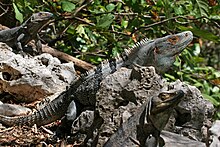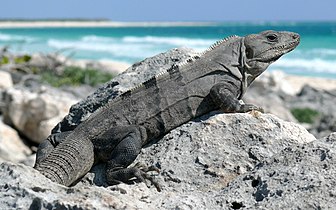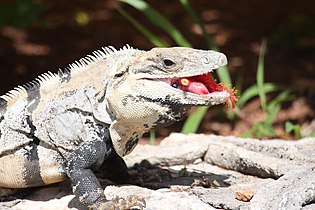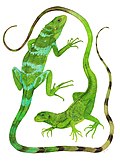| Ctenosaura similis | |
|---|---|

| |
| in Belize | |
| Conservation status | |
 Least Concern (IUCN 3.1) | |
| CITES Appendix II (CITES) | |
| Scientific classification | |
| Domain: | Eukaryota |
| Kingdom: | Animalia |
| Phylum: | Chordata |
| Class: | Reptilia |
| Order: | Squamata |
| Suborder: | Iguania |
| Family: | Iguanidae |
| Genus: | Ctenosaura |
| Species: | C. similis |
| Binomial name | |
| Ctenosaura similis (Gray, 1831) | |

| |
| Synonyms | |
Ctenosaura similis, commonly known as the black iguana or black spiny-tailed iguana, is an iguanid lizard native to Mexico and Central America. It has been reported in some Colombian islands in the Caribbean Sea and Pacific Ocean, and has been introduced to the United States in the state of Florida. The largest species in the genus Ctenosaura, it is commonly found in areas such as grasslands and forests.
Taxonomy
C. similis was first described by British zoologist John Edward Gray in 1831. The generic name — Ctenosaura — is derived from two Greek words: ctenos (Κτενός), meaning "comb" (referring to the comblike spines on the lizard's back and tail), and saura (σαύρα), meaning "lizard". The specific name — similis — is a Latin word meaning "similar to", a common description found in Linnaean taxonomy when referring to a new taxon.
Description

C. similis has distinctive black, keeled scales on its tail, which gives it its common name. It is the largest member of the genus Ctenosaura. The males are capable of growing up to 1.3 meters (4 ft 3 in) in length and the females are slightly shorter, at 0.8–1 meter (2 ft 7 in – 3 ft 3 in). They have a crest of long spines which extends down the center of the back. Although coloration varies extremely among individuals of the same population, adults usually have a whitish gray or tan ground color with a series of 4–12 well-defined dark dorsal bands that extend nearly to the ventral scales. Males also develop an orange color around the head and throat during breeding season with highlights of blue and peach on their jowls.
Diet and behavior
Black spiny-tailed iguanas are excellent climbers, and prefer a rocky habitat with plenty of crevices to hide in, rocks to bask on, and nearby trees to climb. They are diurnal and fast moving, employing their speed to escape predators but will lash with their tails and bite if cornered. The Guinness Book of World Records lists this as the world's fastest lizard, with a maximal sprint speed of 34.6 kilometres per hour (21.5 mph).
They are primarily herbivorous, eating flowers, leaves, stems, and fruit, but they will opportunistically eat smaller animals (rodents, bats, frogs, small birds and smaller iguanas), eggs and arthropods. Juveniles tend to be insectivores, becoming more herbivorous as they get older. They are known to eat the fruit and live in the limbs of the manchineel, a tree highly poisonous to most other animals. González-García et al. 2009 find that abundance is highly dependent on 3 dimensional structure of landscape, tall vegetation not merely short grass.
Distribution

The black spiny-tailed iguana is native to southern Mexico and Central America, ranging from the Isthmus of Tehuantepec southward to Panama, occurring at sea level to ca. 1,320 meters elevation, but it is absent from interior highlands. Its distribution is irregular and discontinuous on the Atlantic versant where it ranges through portions of Tabasco, northern Chiapas, Campeche, Yucatan, and Quintana Roo in Mexico, much of Belize, Guatemala, and the northern coast of Honduras (often following rivers into interior valleys and canyons), but with only a few isolated and disjunct records southward in eastern Nicaragua, Costa Rica, and Panama. On the Pacific coast its distribution is continuous from extreme southeast Oaxaca and southern Chiapas, Mexico, south through Guatemala, El Salvador, Honduras, Nicaragua, Costa Rica, to the Azuero Peninsula in Panama.
It is also found on many Caribbean and Pacific islands including: Isla Aguada, Isla Contoy, Cozumel, and Isla Mujeres in Mexico; Ambergris Caye, Glover's Reef, Half Moon Caye, Belize; Isla de Utila, Guanaja, Roatán, and the islands in the Golfo de Fonseca, Honduras; Isla de Maíz Grande (Corn Islands) Nicaragua; Coiba Island and Isla del Rey, Panamá; Isla San Andrés and Providencia, Colombia. Its status on a few of these islands, as a native or invasive species is questionable. Some herpetologist presume dispersal to the Islas San Andrés and Providencia, Colombia occurred in the Quaternary, while another suspects these and some other insular populations are "likely" human introductions. It has been introduced and is now established in southern Florida, a few islands in the Bahamas, Malpelo Island, Colombia, and Venezuela.
The black spiny-tailed iguana has been introduced to South Florida and reproduces in the wild in several feral populations. On the southwestern Florida coast, it has been discovered from Collier County north to Tampa Bay. On the southeastern Florida coast, black spiny-tailed iguanas have been found on Key Biscayne, Hialeah, and in Broward County. As this species will opportunistically feed on small vertebrates, such as fish, rodents, eggs, birds, and even hatchling sea turtles it may pose a threat to endangered native species. These iguanas can thrive in both natural and disturbed areas, making them even more of a threat to native species
Reproduction
Mating generally occurs in the beginning of the dry season. Males court females and show interest with low amplitude head bobbing and flick-licking the female. The female, when receptive, will allow mating with a large male. Females may violently reject forced-copulation attempts. Within eight to ten weeks, females will travel to a communal nesting site. There they, and other females, repeatedly visit nest openings, eventually laying clutches of up to 30 eggs. The eggs hatch in 90 days with the hatchlings digging their way out of the sand. These juveniles are typically green with brown markings, although all brown hatchlings have been recorded as well. Juveniles become reproductively mature around 2-3 years old.
Commercial usage
In some parts of Central America, the black spiny-tailed iguana, colloquially called the "chicken of the trees," is farmed alongside the green iguana as a food source and for export for the pet trade (see iguana meat). Although it is heavily hunted it does not appear to be endangered in any of its native territory.
Gallery
-
 A basking female on the island of Cozumel in Quintana Roo, Mexico
A basking female on the island of Cozumel in Quintana Roo, Mexico
-
 A male eating a flower in southern Mexico
A male eating a flower in southern Mexico
-
 A juvenile from Rincon de la Vieja, Costa Rica
A juvenile from Rincon de la Vieja, Costa Rica
-
 An adult male Iguana basking in Santa Rosa National Park, Costa Rica.
An adult male Iguana basking in Santa Rosa National Park, Costa Rica.
References
- Pasachnik, S. (2015). "Ctenosaura similis". IUCN Red List of Threatened Species. 2015: e.T174480A73611567. doi:10.2305/IUCN.UK.2015-1.RLTS.T174480A73611567.en. Retrieved 19 November 2021.
- "Appendices | CITES". Cites.org. Retrieved 2022-01-14.
- Liner, Ernest A. and Gustavo Cass-Andreu. (2008). Standard Spanish, English and Scientific Names of the Amphibians and Reptiles of Mexico (2nd. ed.). Herpetological Circular No. 38. Society for the Study of Amphibians and Reptiles. iv, 162 pp. ISBN 978-0-916984-75-5
- "Ctenosaura similis". Integrated Taxonomic Information System. Retrieved 30 December 2007.
- ^ Malfatti, Mark (2007). "A look at the genus Ctenosaura: meet the world's fastest lizard and its kin". Reptiles Magazine. 15 (11): 64–73.
- Hollingsworth, Bradford D. (2004). "The Evolution of Iguanas: An Overview and a Checklist of Species". Iguanas: Biology and Conservation. University of California Press. pp. 34–35. ISBN 978-0-520-23854-1.
- ^ Köhler, Gunther (1996). "Notes on the systematic status of the taxa acanthura, pectinata, and similis of the genus Ctenosaura". Senckenbergiana Biologica. 30 (1): 33–43.
- Garland, T. Jr. (1984). "Physiological correlates of locomotory performance in a lizard: an allometric approach" (PDF). American Journal of Physiology. 247 (5 Pt 2): R806 – R815. doi:10.1152/ajpregu.1984.247.5.R806. PMID 6238543.
- "Ctenosaura similis (Black Iguana)". Animal Diversity Web.
- Van Devender, R. W. 1982. Growth and ecology of spiny-tailed and green iguanas in Costa Rica, with comments on the evolution of herbivory and large body size. Pages 162-182 in G. M. Burghardt and A. S. Rand, eds. Iguanas of the world: their behavior, ecology, and conservation. Park Ridge, New Jersey, USA, Noyes Publications.
- Friedman, Melissa H.; Andreu, Michael G. (24 November 2015). "Hippomane mancinella, Manchineel". EDIS Institute of Food and Agricultural Sciences (IFAS). University of Florida. Retrieved 9 April 2018.
- Goddard, Mark; Dougill, Andrew; Benton, Tim (2010). "Scaling up from gardens: biodiversity conservation in urban environments". Trends in Ecology & Evolution. 25 (2). Cell Press: 90–98. doi:10.1016/j.tree.2009.07.016. hdl:2027.42/144711. ISSN 0169-5347. PMID 19758724.
- ^ Köhler, Gunther. 2008. Reptiles of Central America, 2nd Edition. Herpeton, Verlag Elke Köhler, Offenbach, Germany. 400 pp. (pages 139–144) ISBN 3-936180-28-8
- Campbell, Jonathan A. 1998. Amphibians and Reptiles of Northern Guatemala, the Yucatán, and Belize. University of Oklahoma Press. Norman. xix, 380 pp. (pages 142–144) ISBN 0-8061-3064-4
- ^ Lee, Julian C. 1996. The Amphibians and Reptiles of the Yucatán Peninsula. Comstock Publishing Associates, Cornell University Press, Ithaca, New York. xii, 500 pp. (pages 206–208)ISBN 0-8014-2450-X
- ^ McCranie, James R. 2018. The Lizards, Crocodiles, and Turtles of Honduras: Systematic, Distribution, and Conservation. Bulletin of the Museum of Comparative Zoology, Special Publications Series, No. 2: 1-666 pp. (pages 273–281)
- ^ Savage, Jay M. 2002. The Amphibians and Reptiles of Costa Rica, A Herpetofauna between Two Continents, between Two Seas. University of Chicago Press, Chicago, Illinois. xx, 934 pp. (pages 435–437) ISBN 0-226-73537-0
- Köhler, Gunther., Milan Veselý, and Eli Greenbaum. 2006. The Amphibians and Reptiles of El Salvador. Krieger Publishing Company. Malabar, Florida. ix, 238 pp. (pages 113–115) ISBN 1-57524-252-4
- ^ Köhler, Gunther. 2002. Schwarzleguane: Lebensweise, Pflege, Zucht. Herpeton, Verlag Elke Köhler, Offenbach, Germany. 142 pp. (pages 110–120, & 128b) ISBN 3-936180-01-6
- ^ Alberts, Allison C., Ronald L. Carter, William K. Hays, and Emília P. Martins (Editors). 2004. Iguanas: Biology and Conservation. University of California Press. Berkeley. xvi, 356 pp. (pages 34–35) ISBN 0-520-23854-0
- McCranie, James R., Larry David Wilson, and Gunther Köhloer. 2005. Amphibians and Reptiles of the Bay Islands and Cayos Cochinos, Honduras. Bibliomania!. Salt Lake City, Utah. xiii, 210 pp. (pages 96–97) ISBN 1-932871-07-1
- Schwartz, Albert, and Robert W. Henderson. 1991. Amphibian and Reptiles of the West Indies: Descriptions, Distribution, and Natural History. University of Florida Press. Gainesville. (pages 387–388) ISBN 0-8130-1049-7
- ^ Powell, Robert, and Robert W. Henderson (Editors). 1996. Contributions to West Indian Herpetology: A Tribute to Albert Schwarts. Society for the Study of Amphibians and Reptiles. 457 pp. (page 105) ISBN 0-916984-37-0
- Barrio-Amorós, César Luis and Gilson Rivas-Fuenmayor. 2008. Spiny-tailed Iguanas (Ctenosaura similis) in Venezuela: A Preliminary Report. Iguana. 15( 3) 160-161.
- "Black spiny-tailed iguana (Ctenosaura similis) - EDDMapS State Distribution". EDDMaps.
- ^ Krysko, K. L. & King, F. W. & Enge, K. M. & Reppas, A. T. (2003): Sarasota county Distribution of the introduced black spiny-tailed iguana (Ctenosaura similis) on the southwestern coast of Florida. Florida Scientist, Lawrence, Kansas, USA; 66 (2): 74-79.
- "SARASOTA COUNTY EXOTIC REPTILE MANAGEMENT PLAN". Sarasota County, Florida, USA. pp. 6–7. Retrieved 2022-04-01.
- Panwar, P (2021). "Changes in escape behaviour of black iguanas (Ctenosaura similis) over an anthropogenic disturbance gradient". Behaviour. 159 (2): 111–131. doi:10.1163/1568539X-bja10110.
- Gonzales (2023). "A species profile for the black spiny tailed iguana". Southeastern Naturalist. 3 (22): 292–314.
External links
 Media related to Ctenosaura similis at Wikimedia Commons
Media related to Ctenosaura similis at Wikimedia Commons Data related to Ctenosaura similis at Wikispecies
Data related to Ctenosaura similis at Wikispecies- West Coast Iguana Research Archived 2006-05-25 at archive.today
- Black Spinytail Iguana Archived 2017-02-13 at the Wayback Machine, Florida Fish & Wildlife Conservation Commission
| Iguanidae | ||||||||||||||||||||||||
|---|---|---|---|---|---|---|---|---|---|---|---|---|---|---|---|---|---|---|---|---|---|---|---|---|
| ||||||||||||||||||||||||
| Taxon identifiers | |
|---|---|
| Ctenosaura similis | |
- IUCN Red List least concern species
- Ctenosaura
- Lizards of Central America
- Reptiles of Belize
- Reptiles of Colombia
- Reptiles of Costa Rica
- Reptiles of El Salvador
- Reptiles of Guatemala
- Reptiles of Honduras
- Reptiles of Mexico
- Reptiles of Nicaragua
- Reptiles of Panama
- Lizards of the Caribbean
- Reptiles described in 1831
- Taxa named by John Edward Gray
